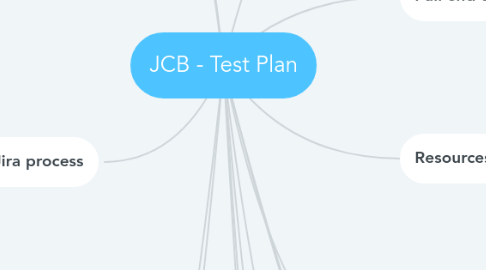
1. Test/Jira process
1.1. 1. Create features in 'Epic' issue type
1.2. 2. Create tests for each Epic and link to Epic
1.3. 3. Organise tests in cycle summary by tests per Epic
1.4. 4. Execute tests and mark pass/fail
1.5. 5. If fail, create bug report and link to failed test
1.6. 6. when the bug gets fixed, re-execute failed test
1.7. 7. Additional testing are done through Exploratory testing and charters are linked to Epic
1.8. 8. Report based on individual Epic
2. Platforms
2.1. Desktop
2.1.1. Chrome
2.1.2. IE11
2.2. Android
2.2.1. Chrome
2.3. iOS
2.3.1. Safari
3. Questions
3.1. IE11 will be deprecated in 2022. still want to do regression on this browser or move to Edge?
4. Features to be tested (JCB)
4.1. links, navigation and content
4.1.1. Products
4.1.1.1. Construction
4.1.1.2. Agriculture
4.1.1.3. Electric
4.1.1.4. Government and defense
4.1.1.5. Logistics
4.1.1.6. OEM solutions
4.1.1.7. Power Generation
4.1.1.8. Rental solutions
4.1.1.9. Industry solutions
4.1.1.10. waste and recycling
4.1.1.11. attachments
4.1.1.12. used equipment
4.1.1.13. workwear and clothing
4.1.1.14. merchandise store
4.1.1.15. power tools
4.1.2. Finance
4.1.3. support
4.1.4. Buy online
4.1.5. Used
4.1.6. Careers
4.1.7. contact us
4.1.8. find a dealer
4.1.9. search
4.1.10. Footer links
4.1.11. Home page
4.2. Language
5. Risks & Issues
5.1. Existing Regression test pack in Jira (MP) is not comprehensive. So Test Analyst(s) may need to create more tests for regression
5.2. Tests are not derived based on google analytics user flow
5.3. any scenarios outside the existing regression pack will not be looked at
5.3.1. back office
6. 2. Bug report should mention about Environment details
7. 1. Create a bug with clear reproduction steps
8. Bug/Jira Process
8.1. 3. Attachments like logs, errors, screenshots should be added
8.2. 4. Priority of the bug should be clearly mentioned
8.3. 5. link to Epic (if not raised based on failed test)
9. Deliverables
9.1. Test Plan document
9.2. Reports in Jira
9.3. Features based on priority
10. Full end to end testing is not in scope
11. Resources
11.1. QA Manager
11.1.1. Manage overall testing and test strategy
11.2. Test Analyst?
11.2.1. number of Test Analysts will be based on the effort required
11.2.2. creating test cases, execute test cases, bug reports, regression testing
11.3. Offshore team?
11.3.1. Regression testing
12. Assumptions & Dependencies
12.1. Performance testing is not a priority
12.2. Testing based on risks (RBT)
12.3. Resources will be available
12.4. QA/pre-prod environment up and running, when testing commences
13. UI
13.1. Look and feel
13.1.1. layout, visual elements, images, links, alignment, positioning and styling of elements, content, based on wireframe, menus, breadcrumbs, other navigational aid
13.1.2. User flow, user journey, payment integration, full checkout process, Login and reg systems, order processing and confirmation, Integrated applications/systems like stockists, Installers, maps, Web forms etc
13.2. Functionality
14. Tools
14.1. Lighthouse - Non functional checks for webpage
14.2. Jira - Managing test cases, bugs and features
14.3. Browserstack - simulate multiple devices and browsers
14.4. Google analytics - prioritise testing based on most visited pages
14.5. W3C link checker - check for broken links (Pre-prod & prod only)
15. Jira Framework
15.1. Marley Project
15.1.1. Epics
15.1.1.1. Tests
15.1.1.2. Bugs
